Timeout: Defending a film critic with a chess painting!
Chess blog for latest chess news and chess trivia (c) Alexandra Kosteniuk, 2011
Hi everyone,
We found this very interesting article written by at Brian Morarty. He chose to defend film critic Roger Ebert with the motif of a chess painting! Very interesting. Here is the chess painting. Below is interpretation of it. For the full article in the context it was written you can access this link.

It was painted around 1730 by James Northcote, a member of the British Royal Academy of Arts.
Northcote was amazingly prolific. Over 2,000 works are attributed to him.
He painted historic and current news events, scenes from the Bible and classic literature, together with hundreds of portraits.
It was his animal paintings that attracted the most attention, though. Northcote made a fortune with his dramatic depictions of jungle cats, elephants, dogs and birds.
This Northcote in the collection of the Worcester Art Museum is not, for the most part, about animals.
It was his animal paintings that attracted the most attention, though. Northcote made a fortune with his dramatic depictions of jungle cats, elephants, dogs and birds.
This Northcote in the collection of the Worcester Art Museum is not, for the most part, about animals.
The Chess Players shows a pair of gentlemen pondering over an endgame. There's a boy standing behind one of the players, and a little dog sitting in the corner.
If you study the painting for a while, you'll notice a couple of interesting details.
For one thing, the chess players clearly are not the center of attention. They're dressed in dark, sober colors, receding into the space of the painting.
By contrast, the boy appears in blazing gold. It almost looks as if he's under a spotlight.
Yet he shows no interest in the chess game. His attention is directed away from the world of the painting. In fact, he appears to be staring directly at you, the viewer.
In his left hand is a sheet of paper, covered with undecipherable characters.
His right finger appears to be pointing at something. But what? The sheet of paper? The man beside him?
And what is that dog doing there?
We'll probably never know. Everyone connected with the creation of this painting has been dead for generations.
I spent a long time sitting on the bench in front of Northcote's Chess Players.
By contrast, the boy appears in blazing gold. It almost looks as if he's under a spotlight.
Yet he shows no interest in the chess game. His attention is directed away from the world of the painting. In fact, he appears to be staring directly at you, the viewer.
In his left hand is a sheet of paper, covered with undecipherable characters.
His right finger appears to be pointing at something. But what? The sheet of paper? The man beside him?
And what is that dog doing there?
We'll probably never know. Everyone connected with the creation of this painting has been dead for generations.
I spent a long time sitting on the bench in front of Northcote's Chess Players.
From Alexandra Kosteniuk's
www.chessblog.com
Also see her personal blog at
www.chessqueen.com
Labels: chess blog, chess painting



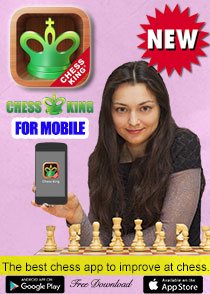












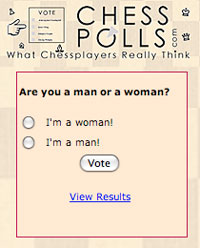
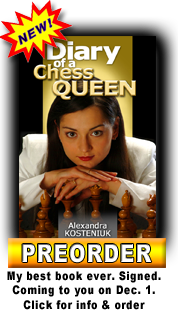










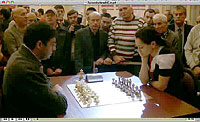
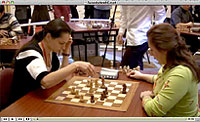
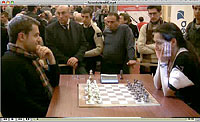

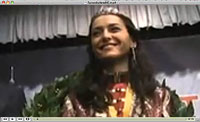

2 Comments:
At March 17, 2011 at 10:30 PM , Jan said...
Jan said...
Well! How interesting. I think the "boy" in gold is not a "boy" at all but a young lady with fashionably cropped air ala the early 19th century during the Regency Period in England. The give-away is, of course, the puffed-sleeves of her gown and the lace. That's not a piece of paper she's holding it is a fan.
The presence of the dog is the clincher. Dogs love chess! In fact, dogs love chess so much that the earliest board games coming out of the middle east used lions and tigers and dogs (oh my), as playing pieces, and dog gaming pieces were used well into the historic period where they were mentioned in writings, including in archaic Greece. By that time, however, the dog had gone from being a faithful companion of the mighty Mother Goddess (the dog was a shepherd, so to speak, of deceased souls who had crossed over to the other side) and thus, a worthy representative of the Goddess' presence in the game, to a derogatory term. Interestingly, the shift in usage was gradual and coincided with the decline of worship of the Mother Goddess and the rise of the patriarchy surrounding archaic local storm gods, such as Teshub and Yahweh. Have I succeeded in putting you to sleep?
To sum it up, the creator used a form of "ancient code" or symbolism to express some very interesting thoughts about the game of chess. In conclusion, notice that the lady's right hand is resting ever so gently on the shoulder of the young handsome man in the painting, and it is her RIGHT hand that features the "pointing finger." Oh, that pointing finger - what I could tell you about that!
Jan Newton
Goddesschess.com
At March 21, 2011 at 8:43 PM , Brian Moriarty said...
Brian Moriarty said...
I am the author of the lecture in question. I've spent many hours in front of the original painting, and I can assure you that all three figures in the painting are male. In fact, I suspect they are intended to represent the SAME MAN in different stages of life. The similarity of their features and hairstyles is too great to be coincidental.
It's also possible they are meant to represent a son, his father and grandfather, but this seems less likely. The clear sequence of clothing colors (aging from gold to brown to gray) is very suggestive.
The boy, I believe, symbolizes the Present, staring directly at us. He is absolutely NOT holding a fan. It is a plain piece of paper covered with a scrawl of undecipherable characters, almost as if it were written in a secret language.
The adult beside him is facing FORWARD, towards the Future. The oldest man faces BACKWARD, into the Past. The oldest man appears to be losing the chess game by one piece, which has just been taken by his younger counterpart.
The dog was a widely-recognized symbol of nobility in paintings of this period. (They were also used as symbols of loyalty, and sometimes of carnal lust, but nobility seems the most likely in this context.)
So the painting functions in two ways: as a portrait of a boy, probably of noble birth, and as an allegory for the passage of time.
The paper with the odd symbols is quite intriguing. I have no explanation for it, and could not find one in any references. It may well be worth investigating.
Post a Comment
Note: Only a member of this blog may post a comment.
Subscribe to Post Comments [Atom]
<< Home